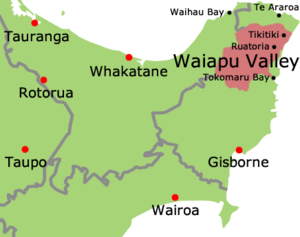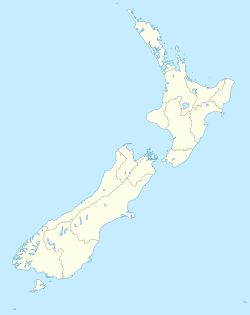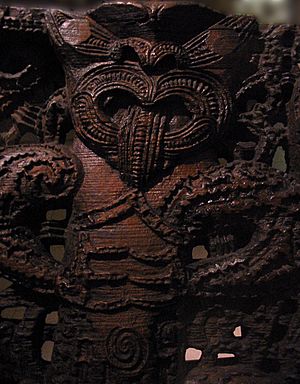Waiapu Valley facts for kids
Quick facts for kids
Waiapu Valley
Te Riu o Waiapu (Māori)
|
|
|---|---|

Waiapu Valley, with Mount Hikurangi in the centre right of the picture.
|
|
 |
|
| Country | New Zealand |
| Region | Gisborne Region |
| Electorate | East Coast |
| Population | |
| • Estimate
(2002)
|
2,000 |
| Time zone | UTC+12 (NZST) |
| • Summer (DST) | UTC+13 (NZDT) |
| Area code(s) | 06 |
The Waiapu Valley, also known as Te Riu o Waiapu in Māori, is a beautiful valley in the northern part of the Gisborne Region in New Zealand. It is on the East Coast of the North Island. This valley is the area where all the water flows into the Waiapu River and its smaller rivers. It covers a large area of about 1,734 square kilometers. The Raukumara Range of mountains forms the western side of the valley, with the impressive Mount Hikurangi standing tall in the middle-west. The towns of Ruatoria and Tikitiki are located in the north-east part of the valley.
This area is very important to the local Māori people, especially the iwi (tribe) called Ngāti Porou. It holds great cultural, spiritual, and traditional meaning for them. In 2002, about 90% of the 2,000 people living here were Māori.
Contents
Exploring Waiapu Valley's Landscape
The Waiapu Valley does not have many people living in it. In 2002, there were only about 1.15 people per square kilometer. This was much lower than the average for New Zealand at that time. Most of the people live in Ruatoria. However, there are also many smaller communities scattered around. In 2006, Ruatoria had 756 people, and most of them (94.8%) were Māori. Nearly half of the people there could speak te reo Māori, the Māori language. The second largest town is Tikitiki, which is the easternmost point on New Zealand's main highway system.
The western edge of the valley is formed by the Raukumara Range. Here, the land goes from 500 to 1,500 meters high. As you move east, the middle and lower parts of the valley are hilly, with heights between 100 and 500 meters. The eastern side has lower flat areas and floodplains close to sea level.
There are many big mountains in the Raukumara Range on the west side of the valley. The most famous is Mount Hikurangi. It is 1,752 meters above sea level and is the highest non-volcanic mountain in the North Island. Other tall peaks nearby include Whanokao (1,428 meters), Aorangi (1,272 meters), Wharekia (1,106 meters), and Taitai (678 meters). These mountains create an amazing view, as described by Te Ara: The Encyclopedia of New Zealand.
The valley gets a lot of rain. It can be 1,600 millimeters per year near the coast and over 4,000 millimeters per year in the Raukumura Range. This water flows into many streams and rivers that eventually join the Waiapu River. The Waiapu River starts where the Mata River and the Tapuaeroa River meet near Ruatoria. It then flows north-east and reaches the Pacific Ocean near Rangitukia. Other rivers in the valley include the Mangaoporo, Poroporo, Wairoa, and Maraehara rivers, and the Paoaruku stream. The Waitahaia River, which flows into the Mata River, is known for its brown trout. These fish were brought to New Zealand for fishing in the late 1860s.
Protecting the Waiapu Environment
In 1840, about 80% of the Waiapu Valley was covered in native forest. It was full of different native plants and animals. There was a smaller area of coastal forest and scrub on the east side of the river, where some trees had been cut down or burned. Between 1890 and 1930, a lot of native forests were cleared and burned to create land for farming animals.
The area often has floods and heavy rain. This, along with the forest clearing, caused a lot of erosion. Large amounts of sediment (like mud and gravel) were washed into the Waiapu River and its smaller rivers. This has greatly changed the landscape.
Since the late 1960s, a lot of effort has gone into fixing the area. People have planted non-native forests in places where erosion was bad and encouraged native scrub to grow back. However, by 2002, there were few natural habitats left. The land was 37% pasture (for animals), 26% Pinus radiata forest (a type of pine tree), 21% native forest, and about 12% kānuka and mānuka scrub. The land was very damaged and had serious erosion problems. About half of the pasture land was likely to erode and was not sustainable. Many of the rivers were full of sediment and considered very unhealthy.
The Waiapu River had one of the highest amounts of sediment flowing through it in the world. In 2000, it was 20,520 tonnes per square kilometer per year. This was more than two and a half times the amount in the nearby Waipaoa River. Because of all the sediment, the Waiapu River is not good for drinking water, and very little of its water is used.
About one-sixth of all the sediment that flows in New Zealand's rivers each year comes from the Waiapu River. It continues to be one of the most sediment-filled rivers globally. About 36 million tonnes of sediment are carried each year, and 90.47 cubic meters of sediment flow into the sea every second. People believe this sediment might have harmed the nearby coast and ocean. Gravel from the river is taken from about 12 different spots near its mouth. This gravel is mostly used for roads in the countryside and for forestry. The water in the river's smaller streams is often much cleaner because they are closer to the native forests in the Raukumura Range.
In lower areas, much of the eroded gravel from the valley settles on the riverbed of the Waiapu River. This makes the riverbed rise quickly. The riverbed rose 1 meter between 1986 and 2007. Because of this, several bridges in the valley have had to be raised. As the riverbed rises, the river itself also rises, causing a lot of riverbank erosion. The banks eroded at a rate of 8 meters per year between 1988 and 1997. By 2003 to 2008, this rate had doubled, with 22 meters per year eroding in 2005 and 2006. This erosion threatens the town of Ruatoria. Walls called groynes have been built to try and move the river away from the town.
Māori History and Cultural Importance
The Waiapu Valley, known as Te Riu o Waiapu in Māori, is within the tribal area (rohe) of Ngāti Porou. Ngāti Porou is the largest iwi (tribe) on the East Coast and the second largest in New Zealand. Mount Hikurangi, the Waiapu River, and the Waiapu Valley itself are incredibly important to Ngāti Porou. They hold deep cultural, spiritual, economic, and traditional value.
Mount Hikurangi is the most important symbol for the Ngāti Porou people. In Māori mythology, it was the first part of the North Island to appear when Māui, an ancestor of Ngāti Porou, pulled it up from the ocean like a giant fish. They believe his canoe, Nukutaimemeha, got stuck on the mountain and is still there, turned to stone, near the top. Nine whakairo (carvings) showing Māui and his whānau (family) were put on the mountain in 2000 to celebrate the millennium. Another Ngāti Porou ancestor, Paikea, is also linked to the mountain. A myth says that Paikea's half-brother, Ruatapu, tried to kill about 70 of his relatives at sea in Hawaiki. Paikea was the only one who survived. He rode to New Zealand on the back of a whale. Ruatapu then sent a huge flood, called Te Tai a Ruatapu, to kill the survivors in New Zealand. Mount Hikurangi became a safe place for people during this flood.
The Waiapu River is also very important to Ngāti Porou. They believe they have had a special connection with the river since Māui's time. The river helps to bring together those who live on its banks. Ngāti Porou believe that taniwha (water guardians) live in and protect the river, which in turn protects the valley and its hapū (sub-tribes). Some taniwha believed to be in the Waiapu River include Kotuwainuku, Kotuwairangi, Ohinewaiapu, and Ngungurutehorowhatu.
Māori lived widely in the Waiapu Valley until the 1880s. In March 1874, there were only 20 Pākehā (New Zealanders of European descent) living in the area. In 1840, Ngāti Porou grew many crops around the river. The valley was a good place to live, offering safety during wars and fresh water and fish.
The first Māori church in New Zealand was built on the banks of the Waiapu River between 1834 and 1839. A few years before, Taumata-a-Kura of Ngāti Porou was captured by a Ngāpuhi war party and became a slave in the Bay of Islands. He escaped later and was protected by missionaries, who taught him about Christianity and how to read and write. When he returned to the Waiapu Valley in 1834, he shared the religion with his people. Whakawhitirā Pā (fortified village), where the church was located, was described as the largest in the region. Just before 1840, the pā had about 3,000 people living there.
Many Ngāti Porou hapū still live in the valley, which has many marae (meeting grounds). In 2002, about 90% of the valley's population was Māori. Traditional culture is still practiced, though it has changed over the last 150 years. The hapū living along the Waiapu River are responsible for keeping the mauri (life force or special nature) of the river healthy. They act as kaitiakitanga (guardians) of the river and its streams. The ways the iwi catch Kahawai fish at the river's mouth are special to that river and are considered sacred.
According to a statement from Hapukuniha Te Huakore Karaka, two taniwha were placed in important spots in the river to protect the hapū from other tribes. One was near Paoaruku and another at the Wairoa River. Karaka said that a bridge was built from Tikitiki to Waiomatatini. Local Māori were worried it would disturb the taniwha. The night before the bridge was finished, a storm washed it away, even though the weather had been calm. After that, one person would drown in the river almost every year. If no one drowned one year, two would drown the next. A local tohunga (expert or priest), George Gage, was asked to help, and after that, there were no more such drownings.
The cutting down of forests and land development in the area, often planned by non-Māori groups, have had a big negative impact on Māori. In December 2010, Ngāti Porou signed an agreement with the New Zealand Government to settle various issues, some of which related to the Waiapu Valley. This agreement included a financial payment of 110 million New Zealand Dollars and the return of culturally important sites to the iwi, totaling about 5,898 hectares.
Ngāti Porou have several whakataukī or pēpeha (sayings or proverbs) about Waiapu Valley. These include:
- Ko Hikurangi te maunga, Ko Waiapu te awa, Ko Ngāti Porou te iwi (Hikurangi is the mountain, Waiapu is the river, Ngati Porou are the people). This is Ngāti Porou's saying of identity.
- Hoake tāua ki Waiapu ki tātara e maru ana (Let us shelter under the thick matted cloak of Waiapu).
- He atua! He tangata! He atua! He tangata! Ho! (Behold, it is divine! It is human! It is divine! It is human! Ah!). This refers to Mt. Hikurangi and comes from the Ngāti Porou haka, Rūaumoko, named after the earthquake god.
- Waiapu kōkā huahua (Waiapu of many mothers). This refers to the valley's large population, its many families, and its many female leaders.
- Waiapu ngau ringa (Waiapu that blisters the hands). This refers to the hard work needed to live in the valley. Men with blistered hands were seen as good potential husbands.
- Kei uta Hikurangi, kei tai Hikurangi, kia titiro iho ki te wai o te pākirikiri, anō ko ngā hina o tōku ūpoko (In Hikurangi inland is the place, but at the sea coast of Hikurangi look down at the blue cod soup, indeed white as the hair of my head). This saying praises home. The white layer of fat on top of the soup showed how much energy it provided.
Notable People from Waiapu Valley
The Waiapu Valley was home to important people like politician Sir Āpirana Ngata. It was also the home of Te Moananui-a-Kiwa Ngārimu, who was one of only three Māori to receive a Victoria Cross, a very brave award.




